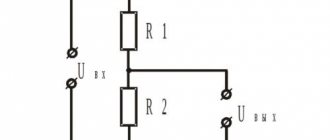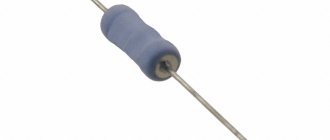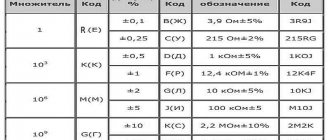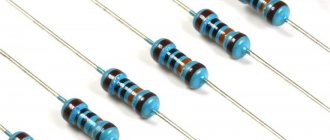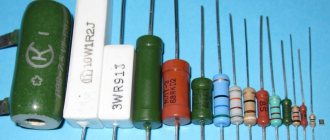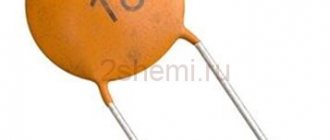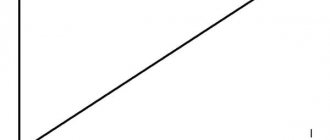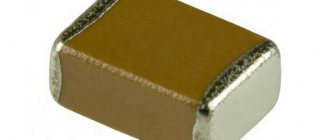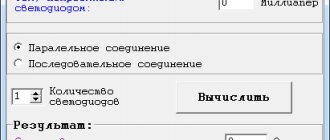It is impossible to determine the resistance value of a resistor “by eye” by size. Various technologies are used for their production; they can have different sizes with the same characteristics. So size is definitely not an indicator in this matter. To determine the value, there is a marking of resistors. Moreover, it may be alphanumeric, or perhaps color. We will talk about what all these letters, numbers, and colored stripes mean.
The alphanumeric marking of permanent resistors is a legacy of the USSR. Now this method is not used, but the element base still exists; there are many such elements in old equipment that is many years old, but which still works. When repairing these “rarities,” you often have to change the resistance, and for this you will have to deal with this type of marking.
There are two types of resistor markings - alphanumeric and color
More “modern” resistors are color-coded (sometimes called “colored”). Stripes of a certain color are painted on the body of the element. Depending on the number of stripes and their position, the nominal value is calculated and the tolerance (permissible error in the resistance value) is determined. Let's figure out how to read the markings. It can be applied to any type of resistor, so it’s useful to understand the topic.
Briefly about the characteristics displayed in the markings
All types of resistors display the value and tolerance. Denomination is the main characteristic, but it’s impossible without approval. The tolerance is indicated as a percentage. It shows the magnitude of the possible deviation of the real value from the declared nominal value.
Sometimes the series or type is indicated
Even on old resistors, the series or type of resistor may be indicated. But this is on “Soviet” ones with alphanumeric markings. This is not available in the color version.
Types of resistors
Resistors are classified according to several criteria.
For discrete elements, division occurs at the installation location:
- introductory _ On the circuit board they are mounted through it. The contacts of such nodes are located according to the axial or radial principle. In the language of electronic engineers, they are called legs. This type of resistor has been used for a very long time. They can be found on both old and modern equipment. They replace SMD elements if their use is difficult or absolutely impossible.
- SMD . They are components of an electrical circuit without legs. The terminals are located on the body. Although it is very difficult to call them such, since they protrude to the surface insignificantly. The advantages of such components include low cost, ease of assembly and saving space on the circuit.
The marking of SMD resistors is no different from the input elements. It is also identified by stripes and color.
Alphanumeric marking of resistors
On resistors from the times of the USSR, numbers and letters are printed, by which the characteristics of a given element can be determined. It costs two or three numbers and a Latin letter. The numbers are the denomination, the letter is the multiplier. With numbers, everything is more or less clear, but you need to remember which letter corresponds to which factor, or have a table at hand.
Table of decoding of letter designations in the marking of old-style resistors
If there is only a number without a letter, the numbers indicate resistance in Ohms, and the tolerance is 20%. That is, if it says simply 33, then you have a 33 Ohm resistor with a tolerance of 20%.
Examples of decoding alphanumeric encoding of resistors
Examples of deciphering codes on resistors:
- 3R9J - 3.9 ohm resistance with 5% tolerance. The letter R means that it is not necessary to multiply by one, that is, there is, in fact, no factor. Since the letter is between two numbers, it also shows the place of the comma. So we get a nominal value of 3.9 ohms. Tolerance is simple - in the corresponding column we find the required letter and look at the permissible deviations.
- 215RG - 215 Ohm resistance with 2% tolerance. The letter R comes after three digits, which means they must be multiplied by 1.
- 1K0J is a 1 kOhm resistor with a tolerance of 5%. The letter K denotes a multiplier of 10³. This means that the number that stands in front of it must be multiplied by 1000. It is much easier to put the letter “K” in front of the designation. The result is kOhm, which is read as “kilo Ohm”.
You can practice determining the denomination
- 12K4F - 12.4 kOhm with 1% tolerance. Since there is a letter K, the number must be multiplied by 1000 (10³), but it is between the numbers, which means it means a comma. We get 12.4 kOhm.
- 10KJ - 10 kOhm with 5% tolerance. The 10³ factor (1000) comes after the 10, so it is 10 kOhm.
- M10J - The letter M stands for a multiplier of 106 or 1,000,000. Since the M comes before the number 10, it must be preceded by a comma. In total we get 0.10 * 1,000,000 = 100,000 Ohm or 100 kOhm. You can also write 0.1 MOhm, but this option is rarely used.
- 2M2K - 2.2 MOhm resistor with 10% tolerance. The multiplier appears between two digits, indicating the position of the decimal point. We get the number 2.2. The letter M means that this number must be multiplied by 1,000,000 (106) which is usually denoted as MOhm. So we get 2.2 mOhm.
- 6G8M - 6.8 GOhm resistor.
- 1T0M - 1 TOM.
Additionally, we recommend reading the article “How to determine and select the power of a resistor (resistance).”
As you probably already understood, without having a table, you can replace the Latin letters with the corresponding Russian ones. It's much easier this way. The only thing you need to remember is that the letter R or E is a multiplier of “1”. The situation is the same if there are no letters, but only numbers. The denomination is indicated in Ohms. If you learn this rule, marking resistors from the Soviet period will be easy to master.
What is a resistor
The resistor, as an element of microcircuits and power networks, gets its name from the English word “resistor”. It, in turn, has the Latin roots “resisto”, which is literally translated into Russian as “I resist”. As its name suggests, its purpose is to resist the flow of charged electrons.
The part is classified as a passive component in an electrical circuit, where it reduces the voltage to the design level. Unlike active elements, a resistor cannot independently amplify signals. According to Ohm's law and Kirhoff's law, the voltage is reduced to values equal to the voltage values multiplied by the existing resistance.
In accordance with GOST, it is depicted in the drawings as a rectangle. To indicate the power of resistors in the diagram, special markings are used in the form of lines and Arabic numerals. It helps to briefly indicate the type and characteristics of the required element.
Color coding of resistors
Often, resistors are very small elements that cannot be labeled. That's probably why they invented color coding. Well, and another way to explain it is that the colors are international. So there is no need to think about the country of origin and keep the specifics in mind. If you understand the principle, this marking of resistors will not confuse you either.
Color coding of resistors: number of strips and the meaning of their location
Let's figure out what the colored stripes on the resistor body mean. There can be three, four, five or six stripes. The first two or three are meaningful data, that is, numbers are encoded under the colors. It is by them that the denomination is determined. After them there is a strip by which the multiplier is determined. This is often (but not always) followed by a gap - a much greater distance than there was between the rings before. The stripes applied after this empty space are the tolerance and temperature coefficient. Moreover, the temperature coefficient is only available with six-element color coding, since only high-precision elements are encrypted with such a “wide” code. In the rest it is simply not indicated. That's all the color coding of resistors.
To determine the resistance value, you need to know which number corresponds to each color. If these are significant figures, the match is the same. It is presented in the table.
What do the colored rings on a resistor mean?
Separately, you just need to remember the value of the multiplier and tolerance, as well as the temperature coefficient. But the last two points, as a rule, are not always taken into account, so it is enough to remember only two columns of the table above.
Note! If there are only three stripes, resistors are marked with an accuracy (tolerance) of 20%, four stripes are marked with an accuracy of 5% and 10%, five and six are more accurate.
Examples of reading color codes on resistors
For example, let's take several color-coded resistors.
Example 1. In the first picture (see below) there are five stripes, one of them is applied through the indentation - this is exactly the tolerance. The color of this ring is red, which corresponds to an error of 1% of the nominal value. Let's look at the remaining bands - these are significant numbers and a multiplier. Let's look at the table:
- first - red - 2
- second - black - 0
- third - black - 0
- fourth - brown - 10 Ohm multiplier.
So we get: 200 must be multiplied by 10 Ohms. It turns out 2000 Ohm or 2 kOhm. The tolerance was determined earlier and it is equal to 2%.
How to decipher stripes on resistors
Example 2 . The second picture contains six stripes. The first four are about the rating and multiplier, the fifth is the tolerance and the sixth is the temperature coefficient of resistance (how much the resistance changes when heated).
Let's look at the denomination:
- first - brown - 1;
- second - black - 0;
- third - black - 0;
- multiplier - red 100 Ohm;
We get that 100 must be multiplied by 100 Ohms. Total: 100*100 Ohm = 10,000 Ohm or 10 kOhm.
Example 3. Let's immediately begin determining the denomination.
- first - red - 2;
- second - black - 0;
- the third - red - multiplier - 100 Ohms.
Why was the third digit defined as a multiplier? Because in the marking the last two digits (if there are less than six) are the multiplier and the tolerance. In this case, we get: 20 * 100 Ohm = 2000 Ohm or 2 kOhm. Permissible deviations of the nominal value - yellow - 0.2%.
Two more examples
Example 4. There are only three stripes on the resistor. This is how resistors with possible deviations from the nominal value of up to 20% are marked. All three stripes are used to decipher the denomination. The first two are numbers, the third is a multiplier.
- first - red - 2;
- second - black - 0;
- third - multiplier - brown - 10 Ohms.
In total we get the nominal value: 20 * 10 Ohm = 200 Ohm with a permissible deviation of 20%.
What is written on SMD resistors
For surface mounting on printed circuit boards, conventional types of resistors are inconvenient to use. Therefore, special technologies have been developed to make them small - long and a few millimeters wide. This allows you to use the board area to the maximum. But even color marking is difficult to apply on miniature resistors. Therefore, SMD resistors have their own markings - alphanumeric. There are three options for this marking:
- three digits;
- four digits;
- three numbers and a letter.
A few examples of how to calculate the value of an SMD resistor
For SMD resistors with medium error
The first two options for marking resistors - three or four digits - are used for resistors with an average error (permissible deviation 5-10%). In them, the first two or three digits are the denomination, the last determines the multiplier. This figure shows to what power 10 must be raised. For those who have problems with raising to a power, the multiplier is written in the figure below. You can also say that the last digit shows how many zeros there are in the multiplier.
Rule for decoding SMD resistance rating codes
The principle of finding the value is similar to the alphanumeric marking of Soviet resistors. The first two or three digits must be multiplied by a factor. To make it clearer, let's look at a few examples of inscriptions on SMD resistance. The multiplier can be taken from the table in the figure above.
- 480 - 48 must be multiplied by 1, that is, this is a 48 Ohm resistor;
- 313 - 31 must be multiplied by 1000, we get 31000 Ohms or 31 kOhms;
- 5442 - 544 must be multiplied by 100, for a total of 54400 Ohms or 54.4 kOhms;
- 2115 - 211 with a multiplier of 100,000, we get 21,100,000 Ohms or 21.1 MOhms.
But to mark low-resistance SMD resistors - with a resistance of less than 100 Ohms - they use a different system. Here you need to decide on the position of the point. Instead of a dot, put the Latin letter R. An example is in the picture below, it’s not difficult to figure out.
Marking of low-resistance SMD resistors
If you see the letter R on the resistor body, this means that the value is small - no more than 100 Ohms. Sometimes there is a variant with the letter K. This letter encrypts a multiplier of 10³ or 1000. This type of notation was created by analogy, that is, the position of the letter indicates the presence of a dot.
Of all the examples, only K47 is worth examining, and maybe even 4K7. The rest are easy to understand. So, K47. Since the letter comes before the numbers, we put a comma in front of them, and the multiplier is known - 1000. So we get: 0.47 * 1000 Ohm = 470 Ohm. Second example: 4K7. Since the letter is between the numbers, we put a comma here, the multiplier is still the same - 1000. We get 4.7 * 1000 = 4700 Ohm or 4.7 kOhm.
Deciphering the codes of precision SMD resistors (high precision)
Surface-mount resistors on high-precision printed circuit boards have their own markings. It is described in the EIA-96 standard. It is used for products with possible deviations in nominal value of no more than 1% (0.5%, 0.25%). On the surface of the resistor there are two numbers and one letter (not R and not K), but their meaning is different:
- two digits indicate the denomination code (note, not the denomination itself, but its code);
- letter is a multiplier.
The denomination is found in several steps. First, the code is found in the table (in the picture below), and the denomination is determined from it. Using the second part of the table, the multiplier is found (highlighted in red). The two numbers found are multiplied and the denomination is obtained.
Code decoding table for high precision SMD resistors
Let's look at a few examples of how to determine the value of precision SMD resistors.
- 01C. Code 01 means 100 Ohm, the letter C is a multiplier of 100. In total we get the nominal value: 100*100 = 10000 Ohm or 10 kOhm.
- 30S. Using the table, we look at code 30. It corresponds to the number 200. The letter S is a multiplier of 0.01. We calculate the nominal: 200 * 0.01 = 2 Ohms.
- 11D. Decoding code 11 - 127, under the letter D the multiplier of 1000 is encrypted. In total, we get 127 * 1000 = 127,000 Ohms or 127 kOhms.
In general, the principle is clear. We are looking for a code, a multiplier, and multiplying. In general, nothing particularly complicated. Simple math. If verbal counting is “not very good,” a calculator can help. Another option is to find a program that deciphers resistor codes.
Power resistors AH 300W in aluminum housing
Structurally, power resistors AH are made with a nichrome winding wound around a rod and placed in a ceramic shell. The solidity of the design is ensured by encapsulation using a heat-resistant compound in an aluminum case, for which they are called resistors of the AHR type (Aluminum Housed Resistor) , “golden” resistors (Gold Aluminum Housed Wirewound Resistor AH).
At the ends of the resistor there are rigid axial leads , fastening the wires using nuts or screws. To install the resistor on the radiator, the housing of the braking resistor AH has mounting holes for screws.
The permissible deviation of the resistance of powerful resistors AH is within ±5% . A number of intermediate values of nominal resistances - E24
E24 - a number of nominal resistances of constant resistors (24 values in the decimal range from 1 to 10)..
The operating elevated temperature of the environment does not exceed +155 ° C , reduced - to -55 ° C , the maximum overheating temperature - up to +275°С . The insulation resistance of power resistors AH is at least 10,000 MOhm. Operating time at rated load is at least 1000 hours .
Resistors are widely used in DC and AC circuits, providing current limitation and voltage distribution, in powerful power supplies, railway transport, industrial traction devices, and are used as braking resistors.
Powerful power resistors AH are also used as an energy-dissipating element when braking asynchronous electric motors in high-inertia lifting and transport mechanisms (cranes, various lifts or elevators, inclined conveyors and transport trolleys), high-inertia (roller tables, centrifuges, smoke exhausters, draft mechanisms) and machine tools ( grinding, drilling and screw-cutting lathes), etc.
Resistor calculation , carried out when selecting the required value, is recommended to be carried out using a calculator, which provides the ability to determine the total parallel or series resistance of resistors, as well as the resistance of resistors in the circuit. A comparison table of powerful resistors AH, S5-35V, S5-36V, PEV, PEVR is given below the tables with the main characteristics.
More detailed characteristics of the presented power resistors AH , as well as an explanation of the marking symbols, overall and installation dimensions are given below.
The warranty period for AH braking resistors supplied by our company is 2 years , which is supported by relevant quality documents.
How to check yourself
If you are not yet confident in deciphering codes, there are two ways to check the resistance of the resistor. The first is software, the second is using a multimeter. The second one is more reliable, since you see the real state of things, and at the same time check the resistance of the element.
One of the programs for deciphering resistor codes “Resistor 2.2”: color coding
It’s easy to find a program for deciphering resistor codes—more than a dozen pop up upon request. They are simple, differing only in the scale of the databases. Not all code options can be found in every one, but popular ones are available everywhere. In these programs, you first select the type of encoding (letters or stripes), and then enter all the data. What you enter is displayed in a special window so that you can visually check the correctness of the entered information. After entering the data, press the button, the program gives you the denomination and tolerance. Compare with what you got.
Checking the resistance with a multimeter
You can also check how correctly you determined the resistance of the resistor by coding using a multimeter. To do this, set it to the “change resistance” mode. We select the range depending on what we counted. We apply one probe to one terminal, the second to the other. The resistance is displayed on the screen. It may differ from the calculated one. The difference depends on the tolerance. The larger the tolerance, the greater the difference can be. But in any case, the readings should be comparable to the found denomination. See the video for details.
Wirewound resistors
For wirewound resistors, a slightly different color classification of resistors is adopted. In any case, the first stripe will be a wide white stripe, which indicates the manufacturing technology (wire). They cannot have more than 4 stripes; the last ring indicates the properties of the microelement. Study our table - it will allow you to understand how to correctly read the ratings of wire devices.
Circuit for wirewound resistors
